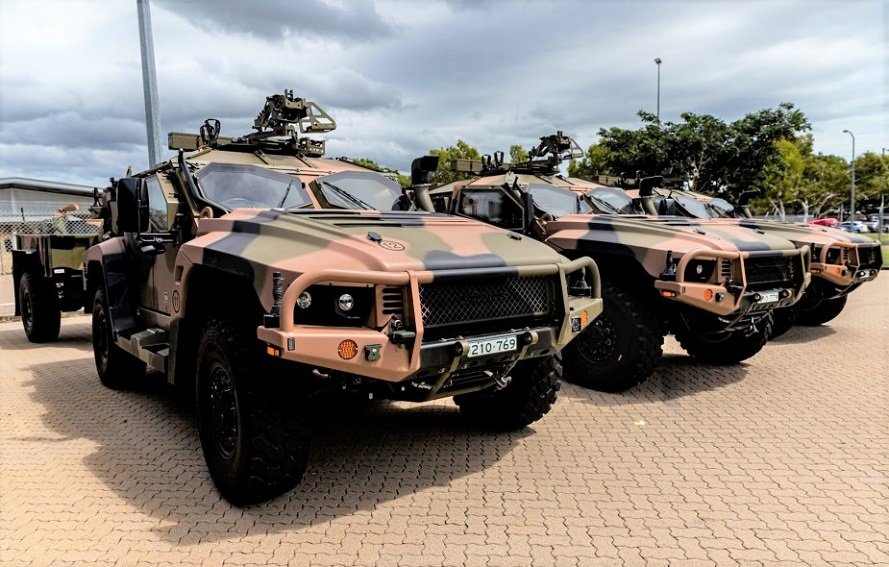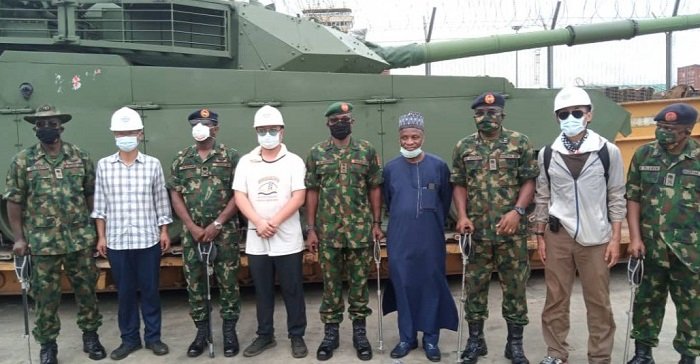
Armoured Vehicle – Weekly Review
1-3 April
Ukroboronprom reported, ten T-80BV and three T-64BV tanks of the 2017 model were delivered to the military. Kharkiv Armored Plant, which is part of the State Concern Ukroboronprom, has transferred 13 units of upgraded combat vehicles to the Armed Forces of Ukraine, according to the concern’s press service. “In particular, 10 T-80 main battle tanks and 3 T-64 tanks of the 2017 model were handed over to the military. In total, Kharkiv Armored Plant manufactured 250 modernized combat vehicles: 162 T-64 tanks of the 2017 model and 88 T-80 tanks,” the report says. The enterprise fulfilled its obligations to the Defense Ministry in a timely manner and within the budget. About 100 units of military hardware were modernized under two state contracts.
 Czech companies Excalibur Army and Tatra Defence Vehicles, both of which are members of the Czechoslovak Group (CSG), are set to begin work on 23 8×8 Pandur II amphibious infantry fighting vehicles (IFV) for the Indonesian Army.
Czech companies Excalibur Army and Tatra Defence Vehicles, both of which are members of the Czechoslovak Group (CSG), are set to begin work on 23 8×8 Pandur II amphibious infantry fighting vehicles (IFV) for the Indonesian Army.
The vehicles were ordered under a contract signed in December 2019 between CSG and the Indonesian Ministry of Defence (MoD), according to a recently issued statement by the group, Armyrecognition reported. The Indonesian Army will receive the armoured IFVs between 2021 and 2022, said the statement, adding that each of the vehicles will be equipped with the Ares UT30MK2 unmanned turret mounting a 30 mm cannon.
French company Arquus reported has completed a full inventory of the means that could quickly be handed to the armies. Roughly 300 armored and non-armored, new and retrofitted vehicles have been identified and a discussion was initiated with the Direction Générale de l’Armement (DGA, French Procurement Agency) and the Structure Intégrée du Maintien en condition opérationnelle des Matériels Terrestres (SIMMT, French Army structure in charge of the maintenance of all Army equipment) to ensure the delivery of these fleets to the Army, even though all production activities were halted in the factories
In this framework, the DGA’s Quality service has been conducting all necessary tests in Garchizy for 13 VAB specifically designed for foreign operations. These 13 VAB have then been handed to the Army. They complete a series of 40 vehicles, started last year, which will reinforce the units currently deployed in the framework of operation Barkhane. Last week, the DGA’s Quality service also conducted a number of tests on a batch of 100 light tactical, non-armored VT4 vehicles in Saint-Nazaire, in order to plan and organize delivery operations to the armies, in liaison with the SIMMT. A first batch of 100 vehicles has already left Saint-Nazaire at the end of last week, and 100 more will be handed over this week. These vehicles will reinforce the means available for domestic operations. 
In order to contribute with supporting the forces in their current operations, both on national soil and in foreign operations, ARQUUS has made sure that numerous support activities are kept running. Dedicated teams have been kept in place on the different industrial plants to ensure the reception and delivery of all spares and organs, in accordance with all support agreements linking ARQUUS and the SIMMT.
These teams ensure, as much as possible, the support of vital fleets such as the 10,000 trucks of the MSS PL contract (TRM10.000, TRM2.000, VLRA, GBC 180), which carry the Army’s logistics, or the VAB, VBL and PVP which constitute most of the combat vehicles deployed in operations. ARQUUS has also made sure that all French VBCI and Caesar© fleets would keep receiving all necessary spares and organs, through partner company Nexter.
Defence-Web reported, the end of this year Ivory Coast’s military will take delivery of 100 trucks from South Korea’s KIA to replace its French-made ACMAT vehicles.
This is according to local media reports citing a government letter stating the order, worth 5 billion CFA francs or $10 million, is to replace the Ivorian Army’s ACMAT vehicles made by France’s Arquus. The vehicles were apparently ordered by the Ministry of Defence but blocked by General Vagondo Diomande, Chief of Staff of the Presidency and Commander of the country’s Security Group (GSPR). The contract was eventually unblocked by the president Alassane Outtara on the advice of his brother Birahima Outtara.
1st Battalion, The Royal Australian Regiment, announced on its Facebook page that it has received its fleet of Protected Mobility Vehicle – Light (PMV-L) Hawkei. In October 2015, the Australian Government announced the purchase of 1,100 Hawkeis from Thales Australia. The Hawkei is a highly mobile, highly protected, 7-tonne vehicle, with in-built systems to allow it to be used as a fighting platform. It has been developed with Vehicle Electronic Architecture to be mission system ready.

Defence-Web reported Bruisertech is making swift progress on the blast trials of its Bruiser 112 armoured personnel carrier (APC), with landmine and improvised explosive device (IED) testing carried out at the Council for Scientific and Industrial Research’s facilities at Paardefontein.
The first and most demanding test took place on 18 March and involved a simulated IED explosion. 50 kg of TNT was placed five metres away from the vehicle and detonated, shifting the Bruiser 112 from the point of explosion and causing superficial damage (flat tyres, damaged storage bins etc.). No hull rupture was seen and the seats and mannequins were still secured after the test.
According to CSIR data, all test equipment survived the blast within specified limits, and the risk of injuries (spine, thorax, neck and legs) was recorded as being less than 10%. After the Bruiser 112 successfully passed the Human Response and Hull Rupture IED tests, it was time for a landmine test under the wheels. This took place on 20 March, and involved 8 kg of TNT. Again, four simulated pairs of legs and a driver were put inside the vehicle. Following the landmine test, the CSIR reported no hull rupture, that the seat and mannequins were secure and no secondary fragments were found inside the vehicle.
Some minor changes will be implemented on the Bruiser 112 after the tests are completed. “The testing programme is designed to improve our product for total peace of mind,” du Toit said. Once final testing is completed, Bruisertech will be able to claim that the Bruiser 112 meets Level 3B protection criteria. The Bruiser 112 has been designed for the African and Middle Eastern market where a cost effective, reliable vehicle with only basic maintenance requirements is needed. It can carry a crew of two plus ten equipped personnel. Kerb weight is 9 000 kg, payload 4 000 kg and combat weight is 10-13 000 kg.
The vehicle is powered by a six-cylinder turbodiesel MWM engine coupled to an automatic transmission, giving a top road speed of 115 km/h and an improved range of over 3 000 km.
The baseline vehicle is configured as an armoured personnel carrier, but Bruisertech developed an ambulance version, which has been fitted with medical equipment such as oxygen tanks, medic kits, stretchers etc. The ambulance layout caters for 4 patients lying down, 2 equipped medics, a driver and all medical equipment. Bruisertech has also started development of a weapons carrier. Other variants, including logistics, are possible as well. An initial ten vehicles are being built on stock for potential customers.
Armyrecognition reported Nigerian Army has inducted locally fabricated Mine Resistant Ambush Protected vehicles into the ongoing war against Boko Haram terrorist group in the Northeast of the country. The MRAPs, which were built by the engineers at the military counter-insurgency operation in the Northeast (Operation Lafiya Dole) were commissioned by the Chief of Army Staff (COAS), Lt. General Tukur Buratai.
German Ministry of Defence (MoD) in December 2019 awarded Flensburger Fahrzeugbau Gesellschaft (FFG) a contract to upgrade 181 deployed Wiesel 1 Armoured Weapon Carrier (AWC) vehicles to extend their operational life to at least 2025.
Armyrecognition reported Argentine Army received its first batch of 10 Ford Ranger 3.2 XLS 4×4 MT6 pick-up trucks on 31 March. The new vehicles will begin to replace the service’s old Mercedes-Benz 230Gs.
The pick-ups, which were built at Ford’s factory in Buenos Aires, were militarised by local company Igarreta. Modifications have included an air intake on the top, a large fender on the front incorporating a winch, reinforced suspension, a new electrical system, NATO-standard lights for night operations, fittings to carry a radio and four FAL rifles, roll protection, off-road tyres, a towing winch, tools, two 20-litre fuel drums, and additional coverings to accommodate troops or cargo in the rear.
The purchase process for the new vehicles began in early 2019, when a request for proposals was issued and by mid-2019 Ford/Igarreta and Toyota Argentina had presented prototypes for evaluation, the latter with a modified Hilux. In December 2019, the Ranger was selected as the winning solution and the first order for 10 vehicles was placed.
4-5 April
Defence media reported U.S. Special Operations Command (USSOCOM) is planning to award a sole-source contract to General Dynamics Ordnance and Tactical Systems (GD-OTS) for the supply of Ground Mobility Vehicle (GMV) 1.1 light tactical vehicles. 
“The United States Special Operations Command (USSOCOM), Special Operation Forces (SOF), Acquisition Technology and Logistics (AT&L), Directorate of Procurement, hereby provides notice of its intent to award a sole source contract under the authority of FAR 6.302-1 to General Dynamics Ordnance and Tactical Systems (GD-OTS) in St. Petersburg, FL”, read a special notice posted on the Federal contracting website, beta.sam.gov.
This requirement will provide one year of additional production capacity and more than eight different vehicle configuration kits. It will also provide up to two years of production support for engineering changes based on testing, user input and other sources along with transportation. According to the special notice, only GD-OTS will satisfy the Government’s requirements to provide the GMV 1.1 vehicle.
Russian Ministry of Defense (MoD) has begun receiving the upgraded T-90M main battle tanks (MBTs) as well as BMPT fire support tracked armored vehicles, according to the official newspaper Red Star.
The T-90M MBTs and Terminator fire support vehicles have been sent to the troops. The Red Star did not detail the number of vehicles of each type delivered to the Russian military.
6-7 April
Estonia has decided to join the Finnish and Latvian vehicle development programme for sustained mobility enhancement to which Patria is delivering the 6×6 vehicle platform. The countries have now signed a joint technical arrangement agreement. The joint development programme aims at common armoured wheeled vehicle system. 
”Estonia joining the development programme is great news and naturally we hope to see Patria 6×6 in serial production. This means that the participating countries are to have very cost-effective solution, which surely is of interest alto to other countries keen on enhancing their army mobility. Though the current situation due to the corona epidemic is very exceptional, it is important that this programme will proceed as planned. We will build security of supply and set up a co-operation model to be prepared for crisis situations together with the local industry”, says Jussi Järvinen, President of Patria’s Land business unit.
The programme is also open for other countries by mutual consent of Finland and Latvia. In case the development will lead to actual vehicle system procurements in the future, the common system will enhance mobility, cost-efficiency, interoperability and security of supply of the armies in both countries
Janes reported South Korean Ministry of National Defense (MND) is planning to improve the overall performance of the Republic of Korea Army’s K1A2 main battle tanks (MBTs) as part of an upgrade programme. The Defense Agency for Technology and Quality (DATQ) announced in March that it will conduct “advanced research” between June and October 2020 to determine how best to enhance the platform’s performance in a number of areas.
Among the upgrades the agency is looking into is the installment of a situational awareness system to allow the crew to better monitor the battlefield situation from inside the vehicle. In addition, a thermal periscope for the driver is expected to be installed.
The agency is also looking to increase the platform’s protection against anti-tank missiles by removing the existing armour and installing a new high-performance special armour. Moreover, the DATQ is considering equipping the tank with an active defence system capable of intercepting such missiles.
To improve manoeuverability, the tank’s existing hydro-pneumatic suspension will likely be replaced with an in-arm suspension unit (ISU) similar to that used by the RoKA’s K2 MBT. Moreover, an auxiliary generator will be installed, and the engine’s output is expected to be increased, although it is undecided as to whether this will happen by upgrading the existing engine or installing a more powerful one.
The crew’s protection against chemical, biological, and radiological (CBR) threats is set to be enhanced through a combined environmental control system that will moderate the temperature within the vehicle.
The DATQ is also examining the feasibility of a remote weapon station. If integrated into the commander’s sight, this would not only further enhance situational awareness but also provide the commander with the ability to engage some targets independently of the gunner.
8-10 April
Janes reported, Portuguese Army is seeking to acquire 4×4 Joint Light Tactical Vehicles (JLTVs) through the US Foreign Military Sales (FMS) programme starting in 2020, Lieutenant Colonel Ricardo Manuel dos Santos Camilo, head of the capabilities branch of the army general staff’s force planning division. EUR79 million (USD86 million) was allocated in 2019 to the revised Portuguese Military Programming Law for the acquisition of JLTVs by 2030 for further army modernisation.
However, the total number of vehicles to be procured is currently under review and a final figure is to be set up by June, with other vehicle configurations being considered, Lt Col Camilo said.
The JLTV is intended to gradually replace unprotected tactical 4x4s, such as the Land Rover Defender series and the Toyota Land Cruiser HZJ73LV.
8 April, defence media reported German Army is set to procure 700 GreenLiner 4×4 vehicles to enhance its unprotected military vehicle fleet. The design of the vehicle is based on the G-Class Mercedes-Benz with a six-cylinder 135kW engine. It offers all-wheel drive and automatic transmission making it suitable for exercises and operations including for off-road terrains. Full air-conditioning with cooling package and auxiliary heating makes it suitable use in a range of climatic environments. GreenLiner cabins can host up to four soldiers along with their equipment.
Ukroboronprom reported, Ukraine has imported a large batch of Czech-made BVP-1 (Bojove vozidlo pechoty 1; a licensed copy of the Soviet BMP-1 ground vehicle, which was produced in Czechoslovakia between 1970 and 1989) infantry fighting vehicles (IFVs).
The state company Ukrspetsexport, a subsidiary of Ukroboronprom, has begun delivering 37 BMP-1 IFVs to the Ukrainian Armed Forces. The technical inspection of the batch has started on April 2.
Defence media reported Nigerian Army has taken delivery of a shipment of military vehicles from the China North Industries Corporation (NORINCO). 
According to local sources, NORINCO delivered the first of 17 military vehicles compromising of VT4 main battle tanks, SH5 105mm wheeled self-propelled howitzers and ST1 tank destroys.
International media according Canadian government said that it had renegotiated the terms of a $14 billion light armored vehicles contract with Saudi Arabia, paving the way for exports to recommence.
Vehicle sales had been on hold since 2018 due to tensions between Ottawa and Riyadh over the murder of journalist Jamal Khashoggi and Saudi Arabia’s involvement in the war in Yemen.
Minister of Foreign Affairs Francois-Philippe Champagne, however, said in a Thursday, April 9 statement that Canada had “been able to secure significant improvements to the contract.”


